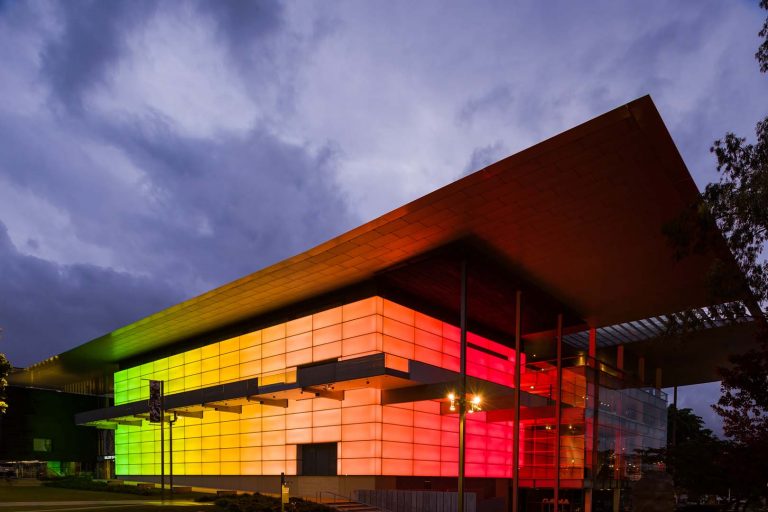We acknowledge the Traditional Owners of the land on which the Queensland Art Gallery | Gallery of Modern Art stands and recognise the creative contribution First Australians make to the art and culture of this country.

James Turrell / United States b.1943 / Night Life 2018 / Commissioned 2017 to mark the tenth anniversary of the opening of the Gallery of Modern Art. This project has been realised with generous support from the Queensland Government; Paul, Sue and Kate Taylor; the Neilson Foundation and the Queensland Art Gallery | Gallery of Modern Art Foundation Appeal / Collection: Queensland Art Gallery | Gallery of Modern Art
James TurrellNight Life 2018
On Display: GOMA
Turrell’s luminous installation for GOMA is a first for the artist and unique in terms of the light works he has created around the world. Night Life uses cutting edge LED technology to light the building from within, transforming the building’s glass façades into a wall of light, a living lantern, from sunset until midnight. The light is not the kind conventionally projected ‘through’ the night, to strike a surface and scatter. Rather, it appears to be a ‘solid light’, gathered within the architecture itself, which breathes out into the night. Turrell says: ‘I believe buildings have a consciousness. . . Light that comes from inside enlivens and gives life.’1
In creating Night Life Turrell makes an instrument of the building, upon which he then plays a special composition in light, bringing ongoing interests, such as the colour temperature of fire, together with a response to this very special site here on the Maiwar-Brisbane River, a gathering place for the people of this land over thousands upon thousands of years.
Endnotes:
1. James Turrell, artist concept statement, October 2016.
James Turrell emerged as one of the foremost artists associated with what is known as the Light and Space movement, which began in Southern California in the mid-1960s. Building on his early research into sensory deprivation (particularly the Ganzfeld effect, in which viewers experience disorienting, unmodulated fields of colour), his art encourages a state of reflexive vision that he calls ‘seeing yourself seeing’, wherein we become aware of the function of our own senses and of light as a tangible substance. These perceptual concerns are coupled with a deep commitment to the natural world and an interest in orienting his work around celestial events. The latter is manifested most fully in Turrell’s ‘Roden Crater Project’ (1979–), his magnum opus currently under construction at an extinct volcano near Flagstaff, Arizona.